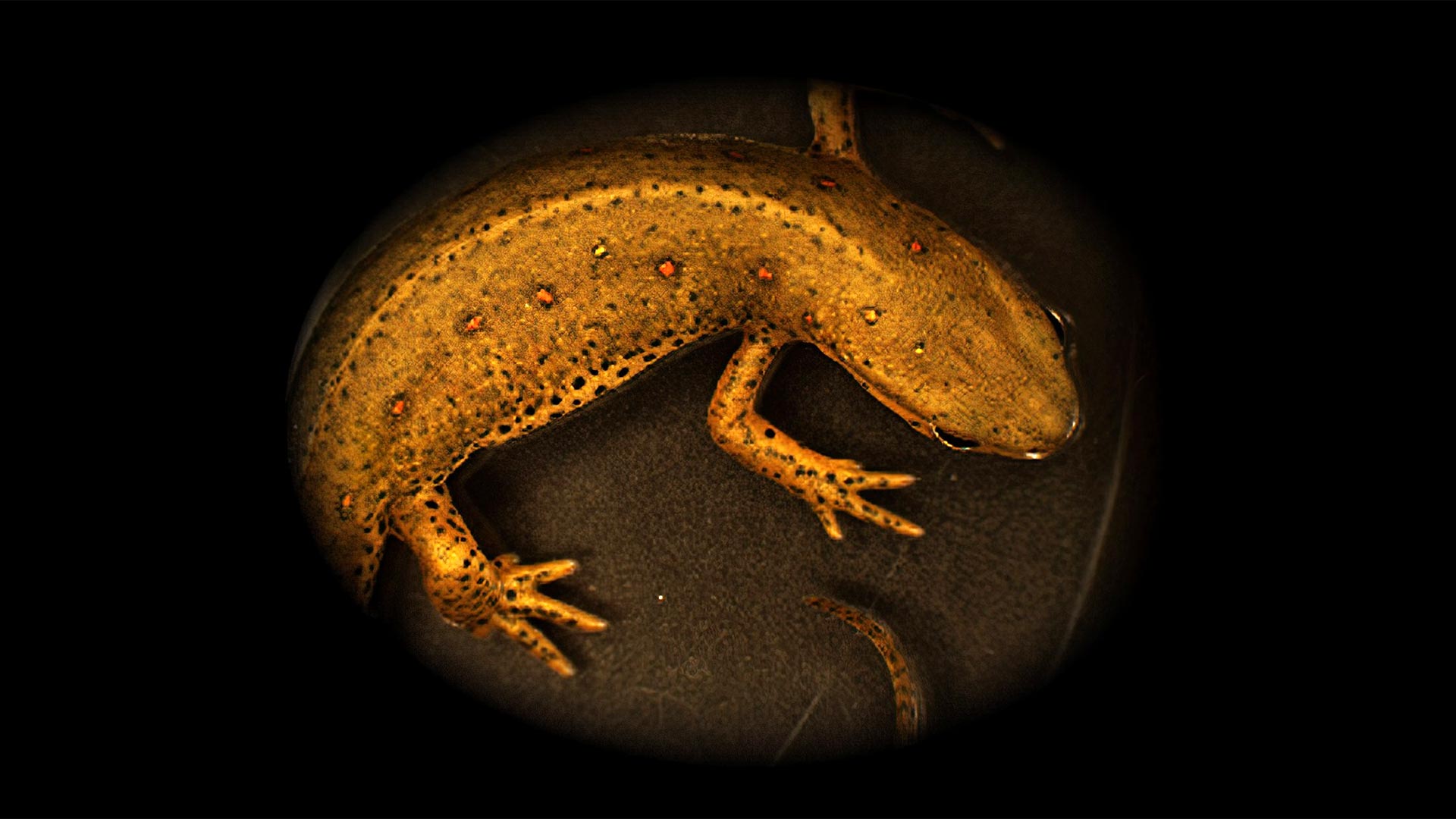نوع السمندل الذي درسته مجموعة يون: سمندل أحمر مرقط Notophthalmus viridescens. من خلال دراسة السلمندر ، الذي يتمتع بقدرات تجديدية ملحوظة ، وجد الباحثون أن وجود الخلايا الشائخة يسرع عملية تجديد الأطراف. تفرز الخلايا العوامل التي تشير إلى ألياف العضلات الناضجة للتخلص من التمايز في الخلايا العضلية السلفية ، وبالتالي تعزيز التجديد. يمكن أن يساعد هذا الاكتشاف الباحثين على فهم سبب محدودية قدرات البشر على التجدد وربما تطوير علاجات جديدة للأمراض المرتبطة بالعمر. 1 رصيد
أظهر العلماء أن ما يسمى بالخلايا الشائخة ، أي الخلايا التي توقفت عن الانقسام بشكل دائم ، تحفز إنتاج خلايا عضلية جديدة لتحسين تجديد الأطراف المفقودة في السمندل.
قد يكون للخلايا الشائخة ، المرتبطة بالشيخوخة والمرض ، خصائص تجديدية. من خلال دراسة السلمندر ، اكتشف الباحثون أن الخلايا الشائخة تسرع تجديد الأطراف عن طريق إرسال إشارات إلى ألياف العضلات لإلغاء التمايز ، مما قد يؤدي إلى علاجات جديدة للأمراض المرتبطة بالعمر.
الخلايا الشائخة هي الخلايا التي توقفت بشكل دائم عن الانقسام استجابة للإجهاد الخلوي ولكنها لم تموت. مع تقدم الكائنات الحية في السن ، يزداد عدد الخلايا الشائخة في الجسم. يعتبر هذا التراكم حاليًا من السمات المميزة للشيخوخة وقد تم ربطه بأمراض مختلفة ، بما في ذلك السرطان. ومع ذلك ، يمكن أن تكون الطبيعة الحقيقية لهذه الخلايا أكثر تعقيدًا وتعتمد على السياق.
تشير مجموعة متزايدة من الأدلة إلى أن الخلايا الشائخة قد يكون لها أيضًا آثار مفيدة ، مثل التئام الجروح أو منع تندب الأنسجة. قبل بضع سنوات ، اكتشفت مجموعتنا أن الخلايا الشائخة كانت موجودة في مراحل رئيسية في تجديد أطراف السمندل. ومن المثير للاهتمام أن مجموعات أخرى استمرت في العثور على هذه الخلايا في سياقات تجديدية أخرى ، بما في ذلك الثدييات. لذا أردنا معرفة ما إذا كانت هذه الخلايا تساهم بأي طريقة في تجديد نفسها ، “هكذا تقول الدكتورة ماكسيمينا يون ، قائدة مجموعة البحث في مركز دريسدن للعلاجات التجديدية (CRTD) ومجموعة فيزياء الحياة المتميزة (PoL) في جامعة TU Dresden ومعهد ماكس بلانك[{” attribute=””>Molecular Cell Biology and Genetics (MPI-CBG).
Senescent Cells Promote Regeneration
The researchers in Yun’s group study salamanders. These animals have unique regeneration abilities and are able to re-grow many organs of their bodies, including lost limbs. “Salamander limb regeneration is a fascinating process. In a matter of weeks, they re-grow a fully functional limb,” explains Dr. Yun.
To check if the presence of senescent cells influences the limb regeneration process, researchers in the Yun group found a way to modulate the number of senescent cells in the wound. The team observed that the presence of senescent cells enhanced the regeneration process.
“When more senescent cells were present in the wound, the animals developed a larger regeneration bud, or – as we call it – blastema. This is a collection of cells that are going to form all the needed tissues in the new limb. The larger the blastema, the more cells are there to regrow the limb and the quicker the regeneration process. The presence of senescent cells seemed to ‘fuel’ the regeneration process,” Dr. Yun says.
“Zombie” Signaling Promotes New Muscle Cells
Looking more closely at the blastema with and without the influence of the senescent cells, the Yun team uncovered a new mechanism that enhances the regeneration process and found that the presence of senescent cells increased the number of regenerating muscle cells. They showed that senescent cells secrete factors that stimulate nearby muscle tissue to take a developmental step back and produce new muscle.
“Our results show that senescent cells use cell-cell communication to influence the regeneration process. They secrete molecules that signal to mature muscle fibers to dedifferentiate into muscle progenitor cells. These cells can multiply themselves as well as differentiate into new muscle cells, thereby enhancing the regeneration process. This signaling appears to be an important part of promoting regeneration,” says Dr. Yun.
For now, the group focused on muscle, one of the most important tissues in the regenerating limb. However, the team is already investigating whether senescent cell signaling also contributes to the regeneration of other tissues.
Lessons From the Salamanders
Yun’s group is working with salamanders to study regeneration and aging processes. “Salamanders are one of the few animal species that seem to defy the natural aging process. They do not develop typical signs of aging and do not accumulate age-related diseases such as cancer. They also have extraordinary healing abilities,” says Dr. Yun. The animals can regenerate almost any organ in their body.
Studying salamanders is helping Dr. Yun and her colleagues at the CRTD understand the principles of the regeneration process and, in the long run, may help solve the puzzle of why humans have very limited regenerative abilities.
Reference: “Senescent cells enhance newt limb regeneration by promoting muscle dedifferentiation” by Hannah E. Walters, Konstantin E. Troyanovskiy, Alwin M. Graf and Maximina H. Yun, 6 April 2023, Aging Cell.
DOI: 10.1111/acel.13826

“هواة الإنترنت المتواضعين بشكل يثير الغضب. مثيري الشغب فخور. عاشق الويب. رجل أعمال. محامي الموسيقى الحائز على جوائز.”





